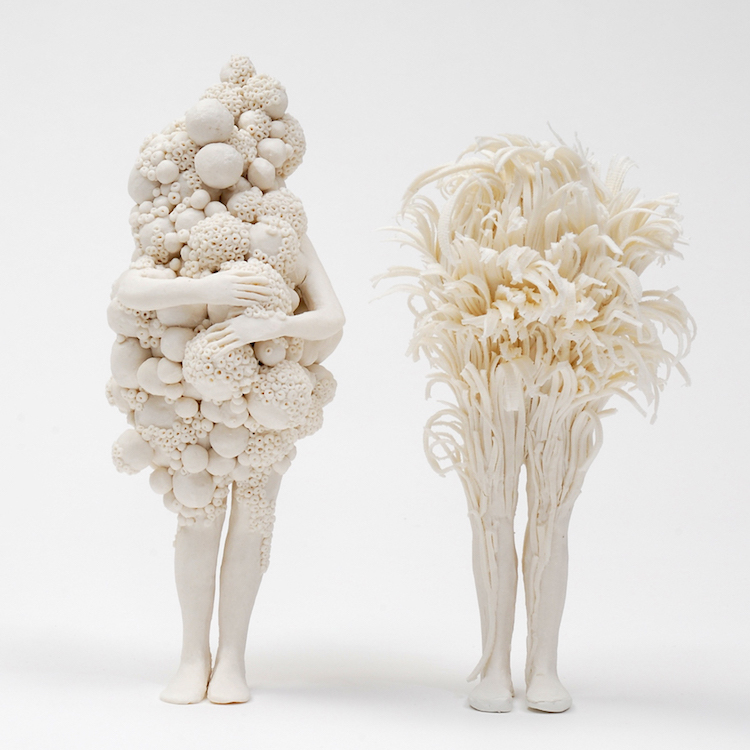Through her work Argentinian visual artist Claudia Fontes explores space and alternative narratives of perception culture, history and society that emerge from the processes of decolonization. That is certainly apparent in her new series of small (the size of her hand) porcelain sculptures. As an Argentinian living in England for the past decade, Colossal writes Foreigners is reflective of Fontes’ own personal experience in a country where the word “foreigner” is widely used a pejorative and discriminatory term.
I began to make [Foreigners] in response to the English landscape that surrounds me and to my cultural understanding of it as a foreigner. I generally find the images out of which they are born during walks in the nearby forest and in the field that begins as soon as I cross the street where I live. During these walks, I concentrate in observing the process of transformation, interaction and the mechanisms of adaptation that happen amongst the creatures that share this particular bio-political system.
Standing alone, in embrace or groups, each piece made from flaxseed paper porcelain is covered in, or consumed by, organic texture such as porous coral, grass and stone shards. Fontes says her choice of scale, material and the care put in each fragile construction are an attempt to denormalize and challenge the validity of the use of the word “foreigner.”
Fontes’ works often explore the concepts of foreigner, other and national identity. In a surreal apparition frozen in time, Fontes’ 57th Annual Venice Biennale (May 13 – November 26, 2017) paradoxical encounter between a monumental white horse and a young woman paints the moment before crisis as 400 broken up rocks are suspended around the central figures.
Its symptoms are, at the same time, the problem that causes it.
The Horse Problem draws from the 19th century cultural icons upon which the invisible structures of Argentina’s cultural identity were falsely built. Employing the genesis of the radical (and exploitative) relationship between horse and man in Latin America, Fontes’ work examines and challenges these invisible structures and the illusionary myth of collective founding, which were forged on the backs of these creatures, Gabriel Giorgi writes in his essay for the work’s catalog.
By highlighting how the destinies of the human and horse species have been intertwined through exploitation from the very moment that horses were domesticated, The Horse Problem offers in a flash, a way to reinterpret history in a different way, a chance to construct an alternative narrative for our future as species.
Fontes’ work is also as conceptually reflexive in considering its own sense of place, the Arsenal. Built during a time when horse-power would’ve been needed to create the brick, iron and wood that make up the building, she also considers the building’s original function: the fabrication of cannons and cannon-balls for the ships, “in what is the first historical example of an assembly line.”
Director of Argentina Fine Arts Museum in Buenos Aires and curator Andrés Duprat writes in his opening essay for the work’s catalog, Fontes use of space expands its narrative.
The scale and arrangement of the sculptural objects in the enormous pavilion—a fundamental and inextricable aspect of the work—allow us to traverse it, to obtain multiple viewpoints, and to submerge ourselves in a plastic and poetic universe that proposes a sensory experience beyond interpretation. Puncturing the narratives, citations, and references that form its foundation, The Horse Problem creates a polysemic and universal scene.
Fontes work also examines the institutional perpetuation of national identity and representation. In an interview with ArtReview, the artist further deconstructed the paradox.
Personally, I see a conceptual problem with the idea of representation: it implies that there is a democratic aspiration behind the selection of projects, but such an aspiration is not viable. It would be funny to have a national referendum in order to choose an artist to go to Venice. I also think the idea of nation is a forced one. Argentina – and any other country – can be seen as many countries in one, depending on who you are and where you live. It seems to me that the fact of any country’s supposing itself to be a singular and homogenous nation was always and will always be a fiction, and a violent fiction at that.
Having said that, representing a country does have an ethical dimension that you have to address in your work, because the work is funded with public money. So I would say it is neither problematic nor an honour: it is a responsibility, and a very big one.
Do you love or loathe these works from the world of contemporary ceramic art and contemporary ceramics? Share your thoughts in the comments section below.
















Add your valued opinion to this post.